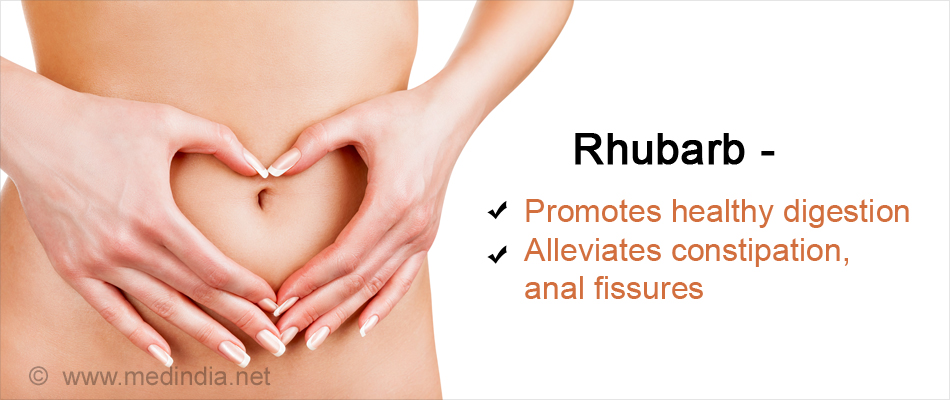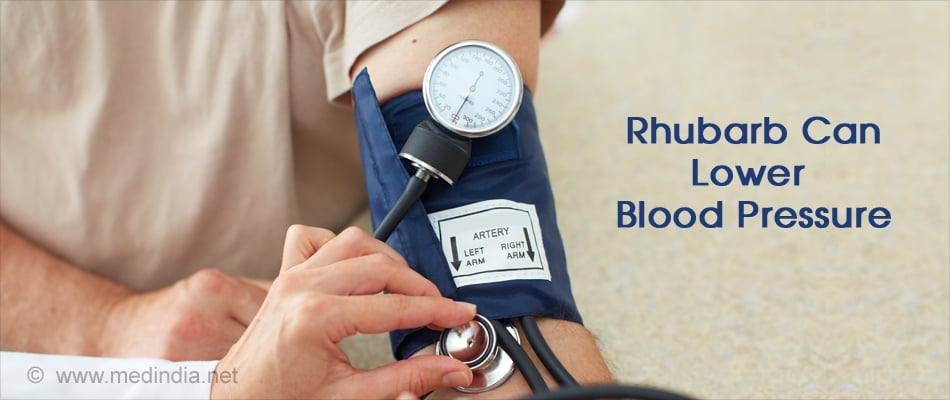- Rhubarb Tannins Extract Inhibits the Expression of Aquaporins 2 and 3 in Magnesium Sulphate-Induced Diarrhoea Model - (https://www.ncbi.nlm.nih.gov/pmc/articles/pmc4151595/)
- Effects of Free Anthraquinones Extract from the Rhubarb on Cell Proliferation and Accumulation of Extracellular Matrix in High Glucose Cultured-Mesangial Cells - (https://www.ncbi.nlm.nih.gov/pmc/articles/pmc4637350/)
What is Rhubarb?
Rhubarb (Rheum rhabarbarum) belongs to the family Polygonaceae. It is herbaceous perennial that grows from short, thick rhizomes. The rhubarb stalks get its color owing to the presence of anthocyanins. The shades vary from crimson red, pink to light green.
Interesting Facts about Rhubarb
- Though rhubarb is a vegetable, in 1947 a New York court declared rhubarb a fruit and thereby, in US, rhubarb is considered a fruit.
- The leaves of rhubarb are poisonous and only the stalks are the edible part of the plant.
- Rhubarb grown in hothouses or heated greenhouses are redder and sweeter than rhubarb grown in the open. They are called ‘hothouse rhubarb’.
- Rhubarb stalks are used in deserts, pies, tarts, crumbles and they pair well with strawberries. In some parts of US they are referred to as ‘pie plant’.
- Rhubarb contains carbon-based quinone molecules, which can carry electric charge in batteries.
Rhubarb Nutrition
Rhubarb is a source of vitamin C, vitamin K, calcium, dietary fiber, potassium and manganese.
It also contains polyphenolic flavonoids like ß-carotene, zeaxanthin and lutein. Rhubarb also contains, in small amount, B-complex vitamins like folates, niacin, riboflavin, thiamine, vitamin B-6 (pyridoxine) and pantothenic acid.
Health Benefits of Rhubarb
Supports Digestive System
Rhubarb has been used as laxative since ages. Rhubarb contains anthraxquinones compounds including rhein, and emodin and glycosides that give rhubarb its laxative and cathartic properties. Rhubarb aids in weight loss. The dietary fiber in rhubarb promotes healthy digestion and alleviates constipation.
Rhubarb has anti-diarrheal properties. Studies have shown that rhubarb tannins extract significantly decrease the fecal water content in colon and inhibit Aquaporins (AQPs) 2 and 3 expressions to alleviate diarrhea condition. Aquaporins are integral membrane proteins that form pores in the membrane of cells, mainly facilitating transport of water between cells. have a major role in regulating water transfer during diarrhea. Rhubarb is consumed to avoid strain during bowel movements so that pain from hemorrhoids or anal fissures is reduced.

Lethal Blow to Cancer
Rhubarb contains pigment parietin which can suppress 6PGD (6-phosphogluconate dehydrogenase) enzyme, one of the drivers for cancer growth. According to studies it was seen that half of human leukemia cells were killed in 48 hours.
Rhubarb contains quercetin, ferulic acid, resveratrol, anthraquinones and Vitamin C that exhibits strong antioxidant and anti-inflammatory properties. Resveratrol is an aromatase inhibitor, which prevents estrogen-dominant breast cancers. Rhein and emodin are not just laxatives but they help to arrest cancer cell proliferation as well.
Rhubarb consumption helps to reduce stress as it fights inflammation and free radicals.
Reverses Kidney Failure in Diabetics
Diabetic nephropathy (DN) is kidney damage characterized by proliferation of mesangial cell (MC) and excessive accumulation of extracellular matrix (ECM). The treatment involves inhibition of the proliferation of MCs as well as the accumulation of ECM.
Rhubarb contains five free anthraquinones (FARs), including rhein, emodin, aloeemodin, chrysophanol, and physcion. Studies have shown that FARs found in rhubarb can reverse the kidney damage in diabetic patients by arresting the proliferation of MCs and the accumulation of ECM.
Lowers Blood Pressure
Rhubarb contains about 351 mg potassium and 14.6 mg magnesium that helps to relax the muscles and lowers elevated blood pressure. Combined with the benefits of dietary fiber and anthocyanin, rhubarb reduces the risk of heart diseases including heart attack and stroke.

Bone Formation
One cup of rhubarb contains 35.7 mg of vitamin K. It also provides around 8% daily value of calcium. Vitamin-K has an important role in promoting osteoblastic (bone formation and strengthening) activity. Rhubarb helps to maintain bone health. However, the absorption of calcium decreases due to oxalic acid. Regular consumption will help to maintain the ratio of bone resorption and formation. Vitamin K deficiency increases the risk of osteoporosis.
Improves Brain Health
Oxidative stress and free radicals can cause brain damage leading to stroke, Alzheimer’s disease. The antioxidant force and vitamins (C, K) present in rhubarb helps to reverse neuronal damage.
Protects Skin & Eyes
The polyphenolic compounds like lutein and zeaxanthin protects the skin and eyes from damages caused by environmental pollution and from free radicals inside the body. Rhubarb helps to keep the vision strong and reduce the risk of developing age-related macular degeneration.

Caveat
Rhubarb is a laxative and long-term use might have few side effects. Consultation with dietitian is vital for long period consumption of rhubarb.
Drug Interactions with Rhubarb
Certain drugs which may interact with Rhubarb should be avoided. Below are mentioned some of the drugs which causes adverse effects.
- Digoxin or Lanoxin may cause potassium loss
- Medications for inflammation – Corticosteroids - reduces potassium in the body.
- Oral drugs -reduces effectiveness of medication.
- Warfarin -can cause diarrhea and bleeding.
- Stimulant laxatives - potassium loss.
- Nephrotoxic Drugs - kidney damage.
- Diuretic drugs -potassium loss.
Recipe
Rhubarb stalks can be roasted. Chopped stalks are added to pies and crumbles. Relish the rhubarb and coconut mousse.
Coconut and Rhubarb Mousse
Ingredients
- Rhubarb stalks - 500-700 gram
- Caster sugar - 50- 100 gram
- Honey- 2 tbsp
- Double cream - 250 ml
- Thick coconut cream - 150 ml
Method
- Add rhubarb stalks to sugar and honey and cook for about 15 minutes till tender.
- Spoon some of the rhubarb through a sieve and collect the juices in a bowl. This is the syrup.
- Rest of the rhubarb is used as pulp.
- Whip the double cream till soft peaks forms.
- Add rhubarb pulp, coconut cream and rhubarb syrup.
- Fold in the cream gently.
- Divide the mousse into glasses and refrigerate for at least 24 hours.
- While serving, add desiccated coconut, broken macaroon, strawberries, and almonds. Drizzle some rhubarb syrup.









